

Skidel
"Town without Memory"


|
|

|

|

|
This summer, my daughter Brandy and I returned to Skidel. Given the precarious state of Belarus after “independence”, we were advised to hire a guide. Brandy was sure this was a foolish extravagance. On the same 4-week trip, we’d be in Romania, Hungary, the Czech Republic, and Poland, going it alone and enjoying whatever discoveries we might make. Nevertheless, I shopped around for a guide to take us into Grodno and Skidel and settled on a guide from Bialystok. We developed about a six-month fax relationship before ever speaking more than 10 words on the phone. My first fax set forth our proposal--5 days in Grodno and Skidel to visit the sites and do a little research in the archives--and asked whether he’d be available and at what price. For $1000 plus expenses, he would be available.
That deflated my balloon a bit. Our trip was to be rather frugal, staying in college dormitories, private homes, and grade B hotels. I put out a query to the members of the Grodno SIG: was this reasonable? Could I expect to find anything more affordable? I also telephoned another researcher the gentleman had accompanied to Belarus. She highly recommended him, but also found the price a bit steep. She also thought I was a bit loony wanting to spend 5 days in Belarus and suggested a shorter trip. My next fax countered his offer: how about $150/day plus expenses for four days? He accepted and planning for the excursion began, though our stay in Belarus was later reduced to two days.

|
Since we’d been unable to obtain visas before leaving home, we spent the first three weeks of our trip wondering if we’d ever get to Belarus. In our third week, though, we arrived in Warsaw and were given bus directions to the embassy from a helpful American Express agent. The embassy was across the river in Praga.
At the embassy, we were told the letter our guide had provided from our Grodno hosts was useless since it lacked an official stamp and we’d have to get a tourist voucher down the block. (Belarus requires proof of lodging.) We walked to a little garage where a Belarussian travel agent (I guessed that was her function, but it wasn’t entirely clear) charged us 80 zloty (about $30.00) for the vouchers, papers that named a hotel in Grodno--had we just bought a hotel reservation? Interestingly, later when we met the guide he also bought a voucher in Bialystok with the name of the same hotel. He paid about $2.00. Back at the embassy, we were given a choice of same-day service, $220.00 US for both of us, or two day service at $120.00 US. The difference meant leaving our passports at the embassy for two days, not something we relished, but we did want to visit Skidel. This also meant staying in Warsaw a day longer than we’d planned, but we made good use of the time and didn’t spend too much money at the huge Praga market. Two days later, we returned and our visas were ready for us. That afternoon, we were on the train to Bialystok.

|
Our guide was waiting for us at the train station in Bialystok, sporting snazzy red shoes and an umbrella to help us identify him. Both before and after visiting Belarus, he showed us around Bialystok and several former shtetls nearby. Our first stop was the small town of Tykocin (Tuh-koh-chin), site of Poland’s oldest surviving synagogue, dating from the 1600s. It was a very interesting building and our guide’s knowledge of and fascination with architecture enriched our visit. The synagogue was originally built by Spanish Sephardic Jews who settled there, though later the Ashkenazi outnumbered them.
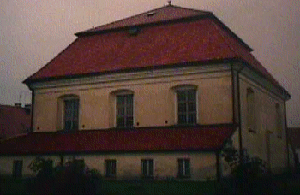
The synagogue-museum was just closing when we arrived, but our guide gained us entry nevertheless and we enjoyed the excellent paintings and a scale model of Tykocin before the war. Afterwards, we walked around the town, noting sites he knew well. Our drive back to Bialystok included a tour of that city’s Jewish heritage sites as well. Our guide was proud of the plaques commemorating Jewish history in this city nearly devoid of Jewish presence today. He had been part of a commission that researched local Jewish history and purchased the plaques. We saw buildings that had been Hebrew schools and synagogues and visited the Holocaust monument at the cemetery. Two churches also were intriguing. One had been the home of the Barbazan Mission for converting Jews to Christianity. Later in his apartment, he showed us the original baptism register for this church. The other, a very prominent building, had a priest who was murdered for helping Jews escape by providing them with false Christian identities. A well-known anti-Semite before the war, this priest found his anti-Semitism did not extend to murder.

|
Our train to Grodno left at 3:00 in the morning and I was surprised to see many more at the station than just us three groggy travelers. Our fellow travelers were all Belarussians. Each carried two or more huge plaid nylon bags, stuffed chock-full with various trade goods. These were the same bags we’d seen over and over at the Praga market near Warsaw. After the initial hustle of hoisting their loot onto the train, this was as jolly and good-natured of a travelling group as could be imagined. Our guide explained that everyone in Belarus engages in trade, crossing into Poland to buy goods for resale back home
We arrived in Grodno about 8:00 a.m. and were enchanted by the view of the city from across the river. The city is indeed strikingly beautiful from this approach: church steeples peeking above dense trees on a hillside. We caught a taxi from the town center to the address of our hosts. The guide had lined up a private apartment for Brandy and I, primarily because hotels are not considered safe for tourists, but also to give us a taste for local lifestyles.
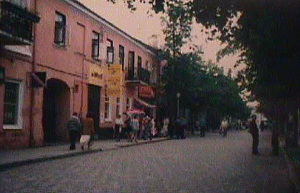
Our hostess was Maria P., a devout Catholic who welcomed us and exchanged tales with the guide in Polish. She and her 25-year old son, Andrej, live in a small one-bedroom apartment on the 4th floor of an unremarkable apartment block. Maria is 61 and her sole income is a monthly pension of $30.00 per month. We inferred that hosting foreigners could be a substantial boon to her income, perhaps financing the many pilgrimages she makes to visit the saints. Maria was highly expressive, laughing and talking animatedly for a good hour after we arrived. During the “Communist era”, Maria and Andrej had three priests sharing the small apartment with them, so Brandy and I would, we were assured, be no imposition. Like others we met in Eastern Europe, Maria and Andrej insisted we take the bed and they would sleep in the living room.
Andrej, who is finishing his degree in economics at the university in Gdansk, agreed to accompany us on our excursions around Grodno. Andrej’s command of Belarussian was a valuable asset. Andrej expressed embarrassment over his hometown, apologizing for the dirty elevator in the apartment building and for the sorry state of some buildings. He would like to emigrate to Poland.
Grodno was full of soldiers and street cleaners the day we arrived. We learned that President Lukushenko was coming to town that day. Not a single other Grodno citizen seemed much interested in this momentous occasion.
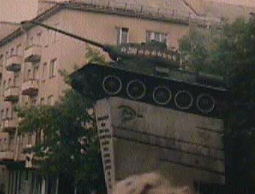
We took a cab to the only surviving Jewish cemetery, a large one on the outskirts of town. The other 3 Grodno cemeteries had been deliberately destroyed, some by the Nazis and some by the Soviets. The shattered headstones were used to pave streets or build homes. Although the cemetery gate was locked, our guide knew a way in through the woods and we entered through a broken fence. Though completely overgrown, the cemetery was still a powerful reminder of what this region once was. After leaving a stone on the memorial to Grodno’s Holocaust victims, we continued walking and encountered a man cleaning graves in a family plot. He had come from Israel for the sole purpose of maintaining the graves of his beloved sister and mother. We walked back along the river to the Grodno synagogue. I was struck by the number of buildings, even fairly new ones, that were crumbling. Clearly, there had been little effort to maintain them, yet another observation was the overemployment of workers in various activities. As elsewhere in Central Europe, we often saw three or four workers engaged in tasks one could do alone.
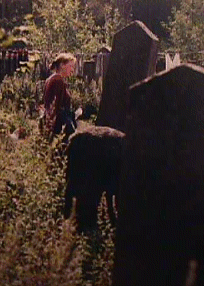
I was disappointed that our guide had not made prior arrangements with his contacts in Grodno. He talked of researchers and historians he knew here, but was unable to reach them by phone during our short visit. We went in search of one at the “Museum of Religion”, supposedly a collection of regional Judaica, but not only was the friend not there but we were unable to gain entrance to the facility either.
Our visit to the archives was similarly unproductive. We were admitted to the Director’s office, a stern older woman who spoke Russian with Andrej while I posed questions. She indicated there were no specifically Jewish records there, but further questioning revealed that the Remission (tax) Lists did exist and could be researched by the archives staff. This would require a $50.00 prepayment and a detailed letter in Russian. I had the feeling that on-site research was discouraged or prohibited, but couldn’t tell if it was the archivist or our guide who didn’t want to be bothered by our attempts. In any case, a visit here in person seemed pointless. Our guide encouraged me to try his friend Igor first, who could research for about “$10 - $15 maximum”, possibly locating and copying all Skidel records. The archives would charge an additional $1.00 per page for photocopies. This sounded pretty good, but now several years and two letters later, I’ve still heard nothing from him.
After some additional sightseeing on foot, we had a completely unimpressive lunch at a restaurant where we had the privilege of sitting beside (according to Andrej) the local Russian Mafia. A much finer meal was later prepared for us by Maria at her flat, but her splurging on meat for us was a source of great confusion as these crazy Americans didn’t eat meat by choice. In the evening, we visited while Maria watched Lukushenko’s 2-hour anti-privatization speech on television. Then Maria boiled water for our baths and I felt more pampered in this apartment where hot water is unavailable than I’ve ever felt in the nicest hotels.

|
A friend of Andrej’s was hired to drive us to Skidel the next morning. Though only about 20 miles from Grodno, it was clear none of our three guides knew the way. Nevertheless, we got there without much trouble. Unlike Grodno’s buildings, her highways are well maintained and rival the best I’ve seen in the U.S. Highlights of the trip included passing Grodno’s International Airport, where flights mostly arrive from other nearby towns but with the extraordinary exception of flights to and from China for various Belarussian traders buying Chinese clothing and pearls.
Skidel, we learned, had been the communist headquarters for this region of the Soviet Union, a “red city”. Our first stop in Skidel was the train station where we took some illegal pictures. Our next task was to find the town center, no small task. Five different locals were consulted before one could identify where the “center” might be. The reason became clear when we found it: Skidel’s formerly vibrant town center, destroyed by the Germans in 1941, had never been rebuilt. Only two blocks of parkland marked what had once been markets, homes, synagogues, schools, shops, mills, and tanneries. On one corner was a tiny open market, a few tables with Polish toiletries and canned foods for sale. During our day in Skidel, we saw evidence of no other markets or stores, though an occasional tavern or repair shop caught our attention.
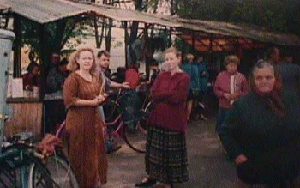
Around the center, we stopped several people to ask where the cemetery (Christian or Jewish) was. Not a soul seemed to know. Nearly everyone we stopped had only recently moved to town. There was also a very visible military presence. Nearby was Skidel’s archives and Andrej and Viktor, our driver, went there to inquire about local records. They were told that the oldest vital records there were just 10 years old! However, we were given a name and address of a local historian, Mr. Borisov Ilya Alexandrovitch.
After an embarrassing case of mistaken identity, we found Mr. Borisov’s home. He was delighted to meet the foreigners and to show us around the town. Mr. Borisov had been born in the same house in 1926 and remembered many Jewish people, but no, he couldn’t remember any particular names. There had been about 8000 people in Skidel before the War and 6000 of those were Jews. The Jews of Skidel spoke many languages, he remembered, and he proudly announced that he spoke a little Yiddish himself.
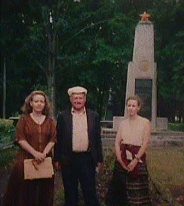
We asked about synagogues and cemeteries and we headed for the site of the old Jewish cemetery. On our way, Mr. Borisov shared that his brother had married a Jewish woman from Kiev and that another foreigner, an Israeli emigrant, had once come to Skidel as well. Now there were two Jewish women in Skidel but there had been none native to the town for many years, as the last Skidel Jewish woman had emigrated “a few years ago”. He informed us Skidel had been strafed by the Nazis because of a small military airport nearby. The entire center, he said, was destroyed “the second day of the war”. His own house, just a few blocks from the center, was spared. He pointed out where a Jewish-owned mill had stood. Two stone synagogues had stood in the center, beside a large Orthodox Church where Lenin’s statue now stands. There had also been a huge wooden Hebrew school in the center, used after the war as a hospital. It burned 25 years ago.
We arrived at the cemetery site, a vast garden with not a gravestone anywhere. A woman tending her vegetables was asked and insisted that her garden was not on the cemetery; no, the cemetery had been over there, where that garden and those houses now stood. Her husband, Mr. Hmisko Aleksej, appeared from somewhere and shared many memories with us. Mr. Hmisko remembered a Jewish caretaker who had lived in a small wooden house near a well. The whole cemetery, consisting of an old and a new section, both very crowded, had a big wooden fence with three ornamented gates. Before the War, he said, the Jewish community had bought additional land from farmers at five times its value. He pointed out where the cemetery and the cemetery fence had been and commented that one family had photographed every stone in the cemetery before emigrating to America about 1939. In 1957, when his wife came to Skidel, part of the cemetery still existed but houses were built and local people took the stones to build their houses.
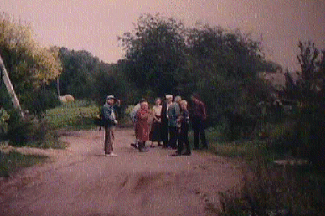
Mr. Hmisko also showed us the place on Zielonkovskaya Street where the Nazis had created a Jewish ghetto. He remembered a day in November of 1942 when the “gendarmes” came, cordoned about 1500 Jews and marched them on foot to the Kielbasin camp near Grodno. A few women and children rode on horse-drawn carts, he said. He did not know what had happened to them afterwards but he believed many Jews escaped with the Russians. (Nazi records tell of two separate Skidel transports, one to Treblinka and another to Auschwitz. Mr. Pluskalowski of Brooklyn, Skidel’s last Jewish survivor, tells us only five of Skidel’s Jews survived Auschwitz.)
We learned of another woman who was also regarded as a town historian. She worked at a nearby poultry processing plant and we drove there to find her. Andrej and Viktor went into the factory while we waited in the car. They returned, reporting she had no pictures of old Skidel (we had asked everyone about pictures) and had no additional information, but she thought two older women she knew might. One however was in the hospital and the other was unavailable for reasons that never became clear to me.
All who know the history of this place are now in their seventies. Someday not long from now, there will be no one with these memories. During our short time there, we hoped to bring back a souvenir of Skidel. Finding nothing made in this town, we came away with only a pre-War German coin picked up on the road to the cemetery.
Skidel seemed very much like a ghost town to us, though it still has many residents. The 1930 business directory listed over 500 businesses and professionals. I would be surprised if today’s Skidel could claim 50. We returned to Grodno and prepared for the train trip back to Bialystok.
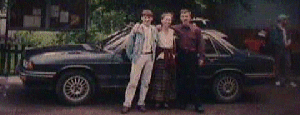

|
The scene at the train station was amazing. People were crowding to get into this narrow, long cage that led to customs and passport control. They were aggressively pushing and shoving, all to be ahead in what looked to us like a regular cattle chute. Andrej somehow secured permission for us to avoid this indignity and we followed him through some empty hallways to the other end of the cattle chute. The customs officer had many questions and made us open our bags. They weren’t searched though and we assured him we had no narcotics. We had been pressured at the station to carry vodka and cigarettes for other travelers and were thankful we’d refused. Apparently, there are strict export controls and only one bottle of vodka and one carton of cigarettes can be taken out of the country at a time. But since these two items were the only Belarussian commodities that could command a better price in Poland, we soon learned the myriad of ways Belarussians found to smuggle them out.
At passport control, the agent took my passport, frowned darkly, and disappeared. Very likely it was the first U.S. passport he’d ever seen. Sometimes passport control can delay travelers for several days. It must have been my lucky day because he did soon return, stamped it, and waved me on. Then Brandy’s was cleared quickly. Next we waited in a windowless room for permission to board the train. Near the door, strong young men were viciously fighting and jockeying for position to be first. The rest of the many people in this room were vigorously trading cigarettes and vodka they’d managed to smuggle through customs. We stood back from the crowd, just trying to take it all in without noticeably staring at the amazing transactions going on all around us.
When the doors finally opened, the rush to the door created an absurd bottleneck. I was ahead of the guide and Brandy and at one point was swept off course to the left of the door. This was bad news as they give only 3 minutes for everyone to board! However, the crush of people pushing from the other direction finally thrust us through the door and we raced to a car. The train car doors were centered with compartments on either side. To the right, we were told that car was closed, yet there were only two men in it. We shrugged and sat down in the opposite compartment instead. Our guide let out his breath and said, “Now we’re in Poland. This is a Polish train.” But what we saw for the rest of our trip was still echoes of Belarus.
The scene in the “full” compartment opposite us began to unfold when the train started. One young man was lying above in the luggage rack, carefully ratcheting apart the ceiling panels of the train car. He worked quickly while the other man and a few friends poured their vodka into plastic water bottles. Then he tucked probably a dozen of these up into the ceiling of the train car, returning each of the panels and screws. During this show, a uniformed agent stood at the door and saw exactly what was happening but did nothing. When he was finished, they all abandoned the car and sat elsewhere until cleared by customs. At the border, the customs officers came through and then everyone was told to get off this train and wait for another. We wondered how the hard-working exporters were going to retrieve their merchandise. Meanwhile, once across the border, some obese women we’d been travelling with from Grodno began pulling cigarette cartons out of their sweaters, skirts, and dresses. It was amazing how quickly our portly friends were transformed into stacks and stacks of cigarettes beside svelte women in baggy clothes.

|
We had planned to stop at Treblinka on the return trip to Warsaw, but the weekend train schedule would have left us waiting several hours for the next train and we didn’t stop. This I regret, as I would like to have visited the memorial to the people of Skidel murdered there.

|
The lack of any tourism infrastructure in Grodno makes unaccompanied travel difficult. The train experience could have been worse, but was at least this time tolerable for anyone with a bit of patience and adventure. I do have the address of Maria and Andrej and could ask if they’d be interested in hosting future travelers or finding other families who would. The expected cost was $10.00 per night, but we chose to pay $30.00 for the combination of lodging, food, and Andrej’s help. If interested, contact me by email “flute@cdsnet.net” or through the Oregon JGS. Lacking private homes, independent travelers would be relegated to the hotels. In Grodno, I did not have the same feeling of welcome and friendliness we found in the smaller town of Skidel, but it may have been that our own needs in Grodno were different.
Russian would be helpful for travelers, but younger citizens have studied English and are willing to try to understand. Both Andrej and Viktor complained about the poor English instruction they received in school, but were both willing to practice their English for us.
If Skidel is a model, visiting the shtetl of your ancestors could be both rewarding and disappointing. Skidel was destroyed in the war and decimated of its people. Yet we were still able to find a few older residents able to share some history with us. None of them, however, remembered any Jewish family names, though they told us Jews and Gentiles had lived together well there. Our visit to my grandmother’s Romanian birthplace three weeks earlier had resulted in meeting a cousin and some wonderful genealogical discoveries in the archives. Nothing like this was either expected or achieved in Belarus.

|
When I think of the Sarnatsky’s fateful decision to emigrate 84 years ago, I can find many reasons to be appreciative. Of course, escaping the horrors of the Nazis tops the list. But the decay and despair today in this part of the world appear on that list too. I can’t help wondering if the region’s woes are more due to the Soviets, the Nazis, or the loss of their energetic Jewish neighbors.
Linda Hugle
Rogue River, Oregon

|

|